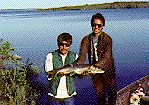
The Land
Southwest Anderson Plain
(in detail)
(Part II)
by
Jean-Luc Pilon
NOGAP Archaeologist
Canadian Museum of Civilization
Vegetation
 There is much variation in the modern vegetation depending on local
land forms which in turn affects local soil drainage. Similarly, recent
local events such as forest fires greatly alter the composition of the
vegetation. In general the region is dominated by black and white
spruce. Other tree species of significance are paper birch, american
aspen, balsam poplar and tamarack. Shrub species often include willows,
alder, dwarf birch, rose, Labrador Tea. Finally various mosses
(especially Sphagnum), lichens, grasses and sedges can be found. Over
much of the landscape which we visited, the forest is easily
characterized as an
open woodland.
There is much variation in the modern vegetation depending on local
land forms which in turn affects local soil drainage. Similarly, recent
local events such as forest fires greatly alter the composition of the
vegetation. In general the region is dominated by black and white
spruce. Other tree species of significance are paper birch, american
aspen, balsam poplar and tamarack. Shrub species often include willows,
alder, dwarf birch, rose, Labrador Tea. Finally various mosses
(especially Sphagnum), lichens, grasses and sedges can be found. Over
much of the landscape which we visited, the forest is easily
characterized as an
open woodland.
Climate
Considering the latitude of the study area--between approximately 67 and 69 degrees North--the climate is not as severe as it is further east in the Northwest Territories. Examination of weather maps clearly indicate the effect that Hudson Bay has on weather patterns north of 60; it acts to depress the Arctic weather systems.| Climatic Data for the southwest Anderson Plain | |
|---|---|
| Mean annual temperature | 10 to 20 F (-6.7 to -12 C) |
| Mean January temperature range | -30 to -15 F (-34.4 to -23.3 C) |
| Mean April temperature range | 0 to 25 F (-17.8 to -4 C) |
| Mean July temperature range | 45 to 70 F (7.2 to 21 C) |
| Mean October temperature range | 10 to 30 F (-9.4 to -1 C) |
| Number of Frost-Free Days | 80-100 |
| Mean Annual Precipitation | 5-15 inches |
| Mean Annual Snowfall | 40-50 inches |
| Mean Snowfall-Dec.Jan.Feb. | 10-30 inches |
| Mean Snowfall-Mar.Apr.May | 10-20 inches |
| Mean Snowfall-Jun.Jul.Aug. | 0-5 inches (least in July) |
| Mean Snowfall-Sep.Oct.Nov. | 20-30 inches (greatest in October) |
| Mean Precipitation-Jun.Jul.Aug. | 4-5 inches |
| Mean Precipitation-Sep.Oct.Nov. | 2-3 inches |
| Primary Wind Directions | |
| December, January, February | |
| Tuktoyuktuk | East |
| Inuvik | East |
| South Delta | North-West |
| June, July, August | |
| Tuktoyuktuk | East |
| Inuvik | North-West |
| South Delta | North-West |

 At more than 67 degrees of latitude, summers
witness 24 hours of sunlight and
the opposite is true in winter months with 24 hours of darkness at the
end of December. This photograph is of the school yard in Inuvik at 9
a.m. in early March.
At more than 67 degrees of latitude, summers
witness 24 hours of sunlight and
the opposite is true in winter months with 24 hours of darkness at the
end of December. This photograph is of the school yard in Inuvik at 9
a.m. in early March.It must be pointed out that there are no meteorologial stations in the southwest Anderson Plain. Rather, the closest stations are located in the Mackenzie Delta (Inuvik and a station in the southern Delta), at Tuktoyaktuk and at Fort Good Hope. The temperature data spans the period from 1948 to 1973, while the precipitation and wind direction information ends in 1972.
Animal Resources
 In many respects the animal species found in the southwest Anderson
Plain are the same as those found elsewhere in the Subarctic, with some
differences in the numbers and concentrations. Information relating
to caribou and certain species of migratory waterfowl (whistling swan,
snow and white-fronted geese) indicate that this area is particularly
important either as wintering range in the case of caribou or as staging
areas during spring migrations in the case of the waterfowl species.
In many respects the animal species found in the southwest Anderson
Plain are the same as those found elsewhere in the Subarctic, with some
differences in the numbers and concentrations. Information relating
to caribou and certain species of migratory waterfowl (whistling swan,
snow and white-fronted geese) indicate that this area is particularly
important either as wintering range in the case of caribou or as staging
areas during spring migrations in the case of the waterfowl species.
 In recent years the numbers of caribou wintering around Tenlen Lake
have been large enough to allow their commercial harvesting. In a one
week period, during the late winter months of the early 1980s, up to
eight Twin Otters were filled with dressed caribou carcases. We have
observed numerous signs indicating the use of the area by wintering
caribou, such as droppings and shed antler. Moose encounters and
sightings occurred with regularity. Some areas are important for
domestic fisheries.
In recent years the numbers of caribou wintering around Tenlen Lake
have been large enough to allow their commercial harvesting. In a one
week period, during the late winter months of the early 1980s, up to
eight Twin Otters were filled with dressed caribou carcases. We have
observed numerous signs indicating the use of the area by wintering
caribou, such as droppings and shed antler. Moose encounters and
sightings occurred with regularity. Some areas are important for
domestic fisheries.



